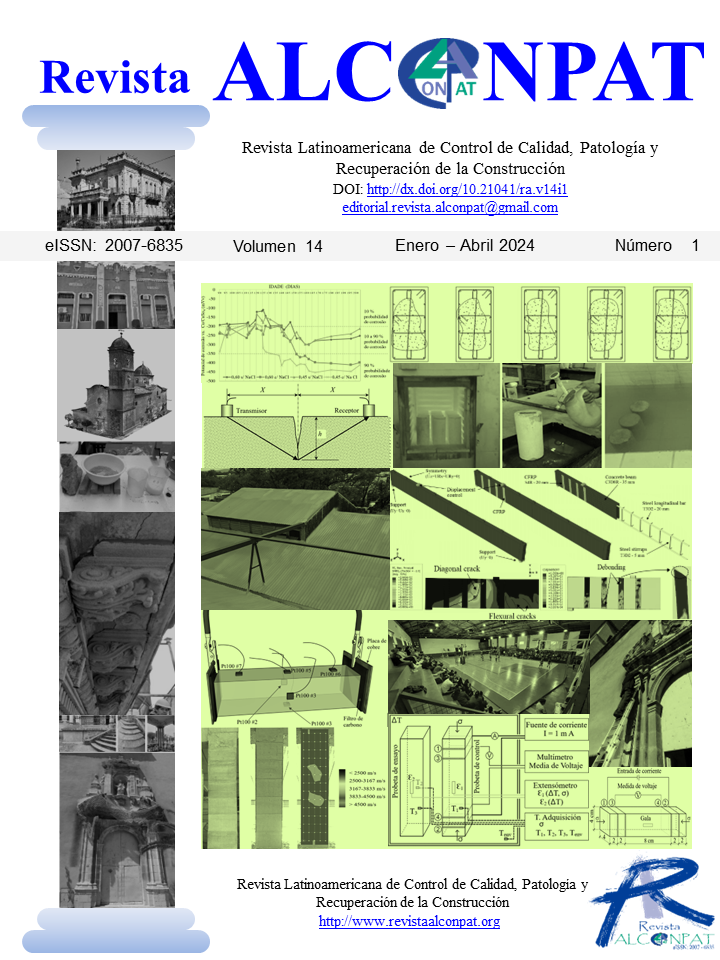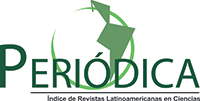RA V14 N1, Message from the Editor in Chief (January - April, 2024)
Keywords:
--Abstract
LATIN AMERICAN JOURNAL OF QUALITY CONTROL, PATHOLOGY AND CONSTRUCTION RECOVERY
http://www.revistaalconpat.org
It is a source of satisfaction and joy for the ALCONPAT Magazine team to see the first issue of our fourteenth year published.
The objective of ALCONPAT Magazine (RA) is the publication of contributions resulting from critical reviews of the state of the art, as well as basic or applied research directly related to the solution of problems related to quality control, pathology and recovery of constructions, related case studies being welcome in these areas.
This issue honors several of the best works presented during CONPAT 2023, which won the A, B, C and Torroja awards. These works were strictly peer-reviewed by the Associate Editors of Alconpat Magazine, expanded, improved and corrected to meet RA standards. A special thank you to the Awards Director, Oscar Cabrera, and his team of referees, who conducted the first phase of evaluation, and who allowed the allocation of prizes to reach a successful conclusion, which went to four countries: Argentina, Brazil, Bolivia and Spain.
This V14N1 edition begins with a work from Brazil, which obtained the award for the best work in category A (Work of Technical-Scientific Excellence in Construction Pathology) of CONPAT 2023. In this, Lucas Chaves Chiaradia and colleagues evaluated the influence of temperature variation on measurements of electrical resistivity and corrosion kinetics in reinforced concrete structures subjected to chlorides. The concretes were characterized physically and mechanically at 28 and 90 days. After 204 days, samples were cycled back and forth from 55°C to −5°C. The results indicated that the corrosion kinetics and electrical resistivity varied with changes in temperature. At higher temperatures, traces contaminated with Cl- showed a high probability of corrosion and a decrease in electrical resistivity values. However, at negative temperature the probability of corrosion was negligible and the electrical resistivity values were the highest.
The second work of this edition, by Beatriz del Moral, Pedro Garces and colleagues from Spain, obtained the C award (Work of Technical-Scientific Excellence in Quality Control of Constructions), as the best work of CONPAT 2023. This research has studied the use of conductive nanoadditions, such as carbon nanotubes (CNT) and graphite products (PG), in cement specimens to develop the functions of sensing deformation and heating. To this end, cement paste specimens have been manufactured with the addition of 1% NTC and 5% PG and heating tests have been carried out in direct current (DC) and alternating current (AC) at 20 V and 40 V. In addition, studied the influence of temperature in deformation perception tests in ranges between 0 °C and 60 °C, obtaining good results in both techniques. Therefore, these materials offer a very interesting alternative in structural monitoring and can have applications in heating infrastructures such as bridges and airports, avoiding the use of corrosive substances.
The third article comes from Brazil, where Maicon de Freitas Arcine and Nara Villanova Menon numerically investigate the reinforcement and adhesive interface of a reinforced concrete beam under shear stresses. The study was based on experimental results collected from current literature. The reinforcement system consisted of the use of carbon fiber reinforced polymer (CFRP) blankets glued in a “U†shape in critical shear regions. The numerical simulation results were considered efficient. Small differences in ductility were observed between the simulated and experimental beams, because the sliding of the reinforcing bars was not considered. Even with reinforcement, brittle collapses are still observed, as a result of part of the CFRP detaching.
In the fourth article from Brazil, Rogerio Cerqueira da Silva and Y. B. Gomes evaluate the behavior of the physical, mechanical and elastic parameters of concrete manufactured with different water/cement ratios, subjected to different temperature levels, using the propagation of ultrasonic waves. After exposure to high temperatures, cylindrical and prismatic concrete samples were subjected to slow and sudden cooling, demonstrating the influence of the type of cooling on compressive strength, elastic modulus, mass loss and wave propagation speed. Statistically significant multiple regression models were developed with a confidence level of 95% as predictors of the strength and stiffness of the concrete through the velocities obtained by the ultrasonic tests, which allows controlling and verifying the integrity of the structures after situations. of fire.
The fifth article, by Salvador Ivorra and colleagues, comes from Spain. This work obtained the Eduardo Torroja award, as the best unpublished work of CONPAT 2023 and describes the studies carried out and the intervention carried out for the restoration of the cover of the façade of San Pedro Apóstol in the Parish Church of Agost. This doorway was made at the end of the 18th century in limestone. After a first inspection and graphic survey, the injuries, their origin and the solution to them were identified, using advanced restoration techniques. Stone elements damaged or destroyed by the passage of time are composed of calcite, dolomite and silica, with gypsum joints, and have been reconstructed either by the use of new elements or, for the most part, by volume recovery systems initial with the use of a light polystyrene core, lime mortars, expanded clay, fiberglass and carbon along with resin infiltrations in the disintegrated areas. After a delicate intervention process using innovative techniques, the façade completed its restoration in June 2023.
The sixth work in this number is written by José Luis Gómez and colleagues from Argentina. In it they discuss the modifications made to a metal structure built in 1930, made up of triangular reticulated beams supported on 60 cm thick perimeter walls and 14 interior metal columns to cover an area of 875 m2 that housed the activities of the city's central market. by Dean Funes. In the 1980s, municipal management proposed its recovery for new sports uses, presenting the structural challenge of eliminating intermediate supports. The project and construction date from that time, and therefore the validity of the concepts and solutions adopted are discussed, as well as the importance of a maintenance plan to guarantee the degree of safety of the work. This work obtained the B award (Work of Technical-Scientific Excellence in Construction Recovery), as the best work of CONPAT 2023.
The seventh work in this issue was written by Gustavo Ergueta and colleagues from Bolivia, who obtained an Honorable Mention in Category A (Technical-Scientific Excellence in Construction Pathology) of CONPAT 2023. The study discusses the results of the evaluation of reinforced concrete structures using non-destructive testing (NDT) based on ultrasonic pulse velocity (VPU) with the objective of determining the integrity and uniformity of the concrete, as well as detecting possible anomalies caused during construction or by external factors. The results showed the distribution of damage in a structure affected by fire, the measurement of the depth of cracking in a concrete element and the uniformity in different structural components, which subsequently allowed the development of the corresponding structural rehabilitation procedure. The study demonstrates the effectiveness of NDT and VPU in the evaluation of reinforced concrete structures, allowing immediate repair and rehabilitation decisions to be made.
The eighth article that closes the edition is another that obtained the Honorable Mention award in Category B (Technical-Scientific Excellence in Construction Recovery) of CONPAT 2023 and belongs to Enrique Zanni and J. Capdevila from Argentina. This work details the diagnosis and structural emphasis of the Tampieri Palace, within a comprehensive restoration project. The building has high heritage value, constituting one of the two existing palaces in the Province of Córdoba, Argentina. It presents fractures in load-bearing masonry, caused by differential settlements, as it is founded on collapsible silt affected by cyclical variations in the water table. The methodology consisted of surveying the existing injuries, carrying out searches and technical and historical investigation of its construction to diagnose its structural and construction status. The intervention was divided into two stages: a) stabilize and seal the building, and b) rehabilitate and restore facades and interiors. It is concluded that driven micropiles constitute a valid alternative to refound buildings in saturated soils, with minimally destructive interventions.
We are confident that the articles in this issue will constitute an important reference for those readers involved with issues of evaluations and characterizations of materials, elements and structures. We thank the authors participating in this issue for their willingness and effort to present quality articles and meet the established deadlines.
At the beginning of 2024, I must once again give broad recognition to the original editorial body and those who have joined this initiative that has taken us to where we are now. But without a doubt, the greatest recognition goes to our article authors, who have trusted our journal and have invested time, money and effort to publish their research work with us, despite the fact that many of them have had better options in their moment. The recognition is extended to our readers, like you, who read us and cite the RA internationally.
At the close of this V14 N1 2024, 13 years after starting operations, our performance as Alconpat Magazine was finally rewarded with our inclusion in one of the two best indexes for magazines such as Elsevier's Scopus. We already have a modest impact factor (0.2), which I am sure will increase thanks to you, our readers, and the quality of our articles. Our membership in Scopus has its historic beginning on December 29, 2022, the date on which we received approval from Elsevier. We hope during 2024 to apply to Journal Citation Reports, which is the index with the greatest international coverage and quality. These are reasons to celebrate for our community that has made a scientific investment in our journal waiting for moments like this. Congratulations to all.
By the Editorial Board
Pedro Castro Borges
Editor in chief
Downloads
References
--
Published
How to Cite
Issue
Section
License
_______________________________
License in effect from September 2020
You are free to:
- Share — copy and redistribute the material in any medium or format for any purpose, even commercially.
- Adapt — remix, transform, and build upon the material for any purpose, even commercially.
- The licensor cannot revoke these freedoms as long as you follow the license terms.
Under the following terms:
- Attribution — You must give appropriate credit , provide a link to the license, and indicate if changes were made . You may do so in any reasonable manner, but not in any way that suggests the licensor endorses you or your use.
- No additional restrictions — You may not apply legal terms or technological measures that legally restrict others from doing anything the license permits.
Notices:
You do not have to comply with the license for elements of the material in the public domain or where your use is permitted by an applicable exception or limitation .
No warranties are given. The license may not give you all of the permissions necessary for your intended use. For example, other rights such as publicity, privacy, or moral rights may limit how you use the material.

















.png)














